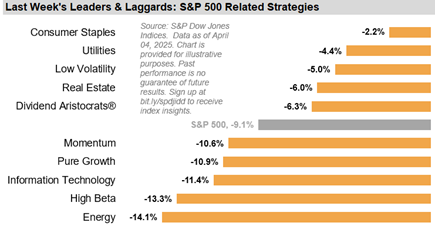6 minute read
What Happened During the Past Couple of Days?
In the past two trading days, the three primary U.S. indexes had the following point and percentage drops:
- Dow Jones Industrial Average: 3,910 Points, -9.3%.
- S&P 500 Index: 597 Points, -10.5%.
- NASDAQ Composite: 2,013 Points, -11.4%.
This was a reaction to the tariffs that Trump announced on Wednesday afternoon (after market close), which were much larger than expected. "In those cases, in which such reciprocal tariff increases were made, they were roughly one-half of those charged to the U.S. as calculated by the administration”:

Morgan Stanley provides a good summary of the current macro environment: “By the dramatic price action across markets, it is evident that Wednesday's tariffs announcement was more hawkish than market participants expected. The proposed tariffs are historically large and significantly change the baseline trading arrangements of the United States. The escalation of tariffs raises recession risks, but our base case is that the US economy slows notably but avoids a prolonged contraction. An additional pullback in aggregate demand driven by reduced business and consumer spending and/or contractionary fiscal policy leading to a fall in job creation could lead to a recession. Investors should not expect the Fed to save the economy from recession.”
So, What Can Investors Do?
First off, we have noted that predicting the direction of stock markets is likely to be a fool’s game, and this time is likely to be no different.
But what can an investor do during these admittedly fearful times? Three things come to mind:
- Diversify Internationally
- Position oneself into defensive sectors.
- Remain Patient and Give Things the Power of Time
Diversify Internationally
Being diversified internationally by investing in non-U.S. stocks can be a prudent measure, particularly during times like this when adverse effects of events like tariffs might hurt domestic stocks more than non-U.S. stocks.
So far in 2025, investing internationally has shown to be effective. In the chart below is a comparison between the S&P 500 Index (“^GSPC”) and the MSCI EAFE (“MFS=F”) indexes. The S&P 500 Index represents U.S. Large Capitalization stocks while the MSCI EAFE (which is an acronym for “Europe, Asia, and Far East” is an index representing the stocks of International Developed countries and is a proxy for non-U.S. stocks.
The S&P 500 index is represented by the blue-colored line while the MSCI EAFE index is represented by the aqua-colored line. Year-to-Date, in early trading on 4/7/2025, the MSCI EAFE index is lower by approximately 4% while the S&P 500 is lower by approximately 14%, a difference of some 1,000 basis points.

Source: Yahoo! Finance.
One of the things that is notable about the chart is that the correlations were mostly negative in the days of the Trump presidency (January 20th through March 7th), while they have been significantly positive since then. This seems to indicate what while Trump’s tariff announcements have affected markets globally in a significant way – which may or may not be a short-term panic – during those first 18 days in the Trump administration, global market participants may have been signaling something far more fundamental (i.e., not as “panicky”): that global markets’ economies may very well be on a course better than those of the U.S. This latter factor represents a reason investors should be globally diversified.
Position Oneself Into Defensive Sectors
As noted above, while trying to time the holistic market is challenging, there is some evidence to suggest that being more defensively-positioned can help portfolios, at least from a risk-management perspective.
For example, consider the chart below, which represents the total returns from last week (3/31 through 4/4) of various sectors within the S&P 500 plus certain so-called “factor-based” indexes such as Momentum, Pure Growth, and Dividend Aristocrats, which represents those stocks that have increased their dividends in each of the past 25 consecutive years.
Notice that while all of the sectors and indexes were lower last week, but so-called defensive sectors, such as Consumer Staples and Utilities, as well as defensive types of stocks, such as those in the “Low Volatility” space, performed significantly better than the index as a whole. Relative to the S&P 500, these sectors outperformed by the following percentages: Consumer Staples (6.9%), Utilities (4.7%), Low Volatility (4.1%).

Source: Standard and Poor’s.
Sectors such as Consumer Staples and Utilities – industries which are less impacted by an economic downturn – have fared relatively better than sectors such as Information Technology and Energy – areas which are more directly impacted by a recession.
Although our default position is to remain globally-diversified across all sectors and styles of stocks, if an investor is concerned about his or her U.S. portfolio, a shift towards such defensive sectors like staples and utilities – which can benefit significantly from fund flows into these sectors – can be better than simply panicking and exiting the stock market completely.
Remain Patient and Give Things the Power of Time
During these turbulent times, the best action for the majority of investors may very well to be patient and wait. As we noted last month during the (admittedly lower) volatility in the equity markets, stock markets have gone through many adverse events and have historically recovered – and then some.
Representatives from the Trump’s cabinet have been communicating this message. Treasury Secretary Scott Bessent used President Ronald Reagan’s first term as a historical analogy, highlighting that in the first two years following Reagan’s inauguration, the S&P 500 index experienced a drawdown of 25% before rallying more than 180% in the final ¾, or six years, of Reagan’s administration.
Consider the chart below, which shows the growth from an initial investment of $10,000 at the beginning of 1970. More than a half-century later that initial $10,000 capital grew to almost $3 Million, a growth of some 300-fold, which translates into an annualized return of almost 11% (including reinvestment of dividends):
Source: First Trust.
Moreover, seeing significant declines in the middle of a year is not only expected, but typical, including during years in which the stock market finished significantly higher. For instance, during the past two calendar years, U.S. Large-Cap stocks had 10% and 8% intra-year declines respectively, but both finished handsomely by adding nearly ¼ of one’s initial capital each year (including reinvestment of dividends).
Source: First Trust.
Lastly, we should add that, paradoxically, for those investors who have the proper mindset and a long-term focus in mind, times such as this may be one to buy. Recent history provides support for this suggestion: That of the COVID-19 panic.
The S&P 500 index fell to its bottom on March 24, 2020, losing some one-third of capital year-to-date. Investors who had the wherewithal to hang on, however, were richly rewarded with a two-third increase in capital from that point forward though there is no guarantee it will happen this time or be profitable.
We can look at the COVID-19 era performance from a couple of different angles as well. The first is from the Pre-COVID-19 peak of the market through the end of the year. An investor who bought at that peak, rode the market all the way to the bottom, but held on through the end of the year, would have had a 10% increase in her capital, a perfectly admirable end result. Notice that all of her capital would have been earned back (“gotten even”) by the middle of August:
Another way to look at performance is for the entire year of 2020, an increase of nearly 16%:

The lesson learned here is that one of the largest social upheavals in our lifetime – the COVID-19 pandemic – offered a case study in being patient and not panicking when markets were undergoing significant upheaval.
Summary
In closing, there is no doubt that the constantly changing tariff landscape has created significant uncertainty into markets, and as such, has the potential to spill over into the broader economy. Although this environment is certainly challenging, it is one that we believe makes clear that diversification, patience, and a clear investment process are all important recipes for long-term success in investing.
We’ll share more thoughts in our upcoming first quarter investment commentary.
We sincerely thank you for your confidence and trust in us. Please do not hesitate to reach out to us if you have any questions or wish to discuss how all this relates to your specific financial situation in more depth.
IMPORTANT DISCLOSURE INFORMATION
Please remember that past performance may not be indicative of future results. Different types of investments involve varying degrees of risk, and there can be no assurance that the future performance of any specific investment, investment strategy, or product (including the investments and/or investment strategies recommended or undertaken by First Foundation Advisors), or any non-investment related content, made reference to directly or indirectly in this blog will be profitable, equal any corresponding indicated historical performance level(s), be suitable for your portfolio or individual situation, or prove successful. Due to various factors, including changing market conditions and/or applicable laws, the content may no longer be reflective of current opinions or positions. Moreover, you should not assume that any discussion or information contained in this blog serves as the receipt of, or as a substitute for, personalized investment advice from First Foundation Advisors. To the extent that a reader has any questions regarding the applicability of any specific issue discussed above to his/her individual situation, he/she is encouraged to consult with the professional advisor of his/her choosing. First Foundation Advisors is neither a law firm nor a certified public accounting firm and no portion of the blog content should be construed as legal or accounting advice. A copy of the First Foundation Advisors’ current written disclosure statement discussing our advisory services and fees is available for review upon request. Please Note: First Foundation Advisors does not make any representations or warranties as to the accuracy, timeliness, suitability, completeness, or relevance of any information prepared by any unaffiliated third party, whether linked to First Foundation Advisors’ web site or incorporated herein, and takes no responsibility therefore. All such information is provided solely for convenience purposes only and all users thereof should be guided accordingly.







